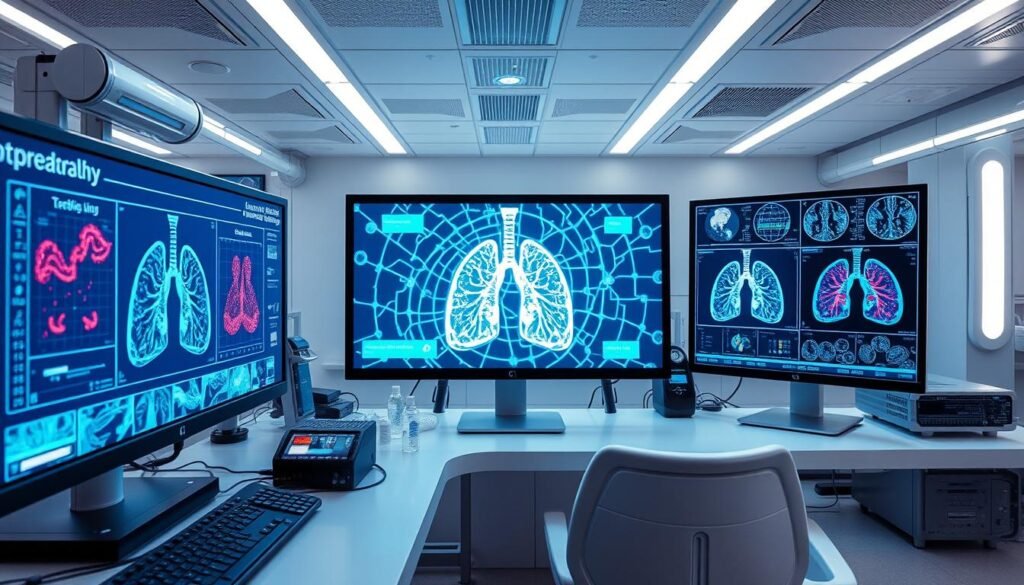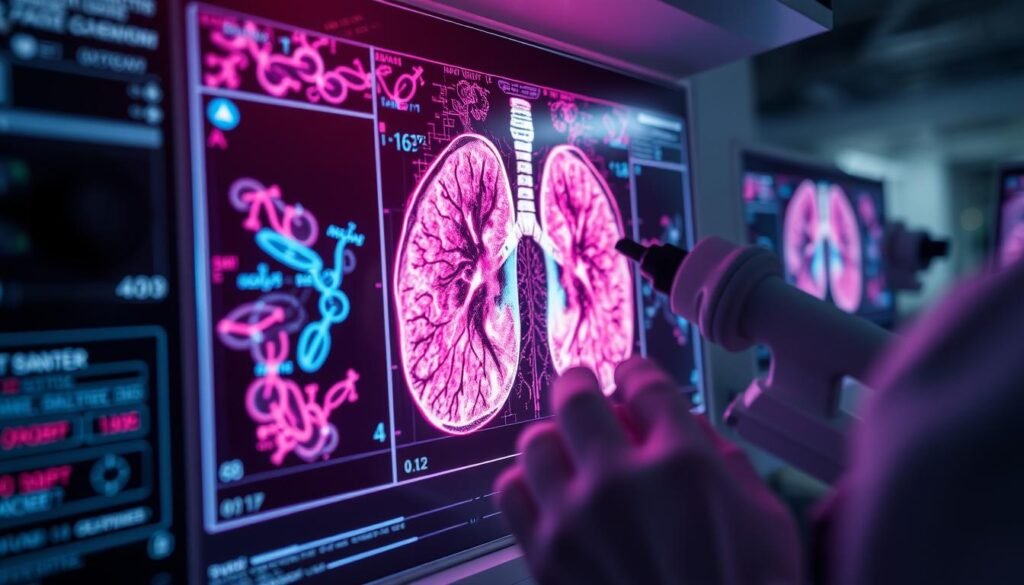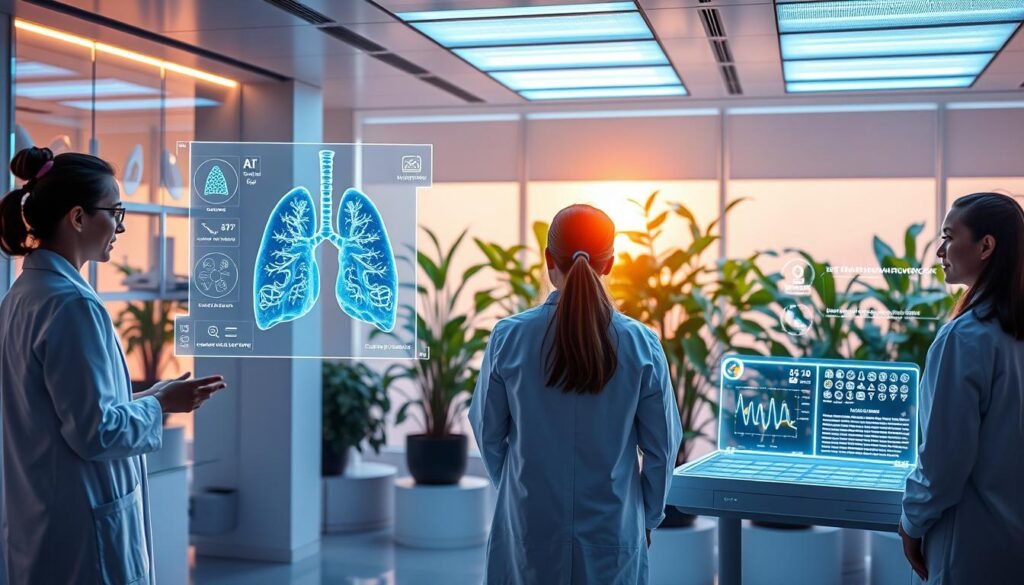Lung cancer causes about 25% of all cancer deaths worldwide, showing a critical need for better diagnostics. Thanks to new technology, there’s hope. Technologies like AI-driven Risk Modeling and Predictive Analytics are making strides.
These innovations are reshaping how we detect and treat lung cancer early. Now, doctors and scientists use them to improve how they handle this disease. They’re changing the game for the better.
Key Takeaways
- Lung cancer remains a leading cause of cancer-related deaths worldwide.
- AI applications in oncology, including for lung cancer, are now FDA-approved.
- Predictive modeling has shown promising results with high AUC scores for lung cancer risk assessment.
- The National Lung Screening Trial demonstrated a significant reduction in mortality through low-dose CT scans.
- AI and deep learning are enhancing image detection and evaluation in lung cancer cases.
Introduction to Lung Cancer Risk Assessment
Lung cancer is the world’s deadliest cancer, causing about 1.7 million deaths in 2020. It makes Lung Cancer Risk Assessment crucial for saving lives. Early identification of those at high risk allows for prompt care and better outcomes. Screening advancements, especially low-dose CT scans, are key for detecting it early.
Early detected lung cancer patients have about a 70% chance of surviving five years. Those found later often have a survival rate below 10%. This huge difference shows why early detection is vital for survival.
Artificial intelligence, like the AI tool Sybil, is changing how we assess lung cancer risk. Sybil has shown great accuracy in predicting lung cancer from scans over six years. Its impressive performance indicates technology’s role in enhancing screening methods.
The path forward is not without hurdles. Challenges in the U.S. include social stigmas and varying Medicaid policies. Interestingly, over 50% of women with lung cancer never smoked. This fact points to the need for wide-ranging screening strategies.
The Importance of Early Detection Strategies
Early detection of lung cancer is key to better treatment and higher survival rates. Low-dose CT scans are important for finding lung cancer early. They use high-quality images with less radiation, spotting small lesions often missed by other methods.
The role of low-dose CT scans in early diagnosis
Low-dose CT scans are very effective for lung cancer screening, especially for those at high risk. The National Lung Screening Trial showed these scans can greatly reduce lung cancer deaths by 39%. By having regular screenings, we stick better to Early Detection Strategies and catch more cancers early.
Statistics on late-stage diagnosis and its implications
A lot of lung cancer patients are diagnosed too late. Only 5% of those with stage 4 lung cancer live five years or more, unlike 55% of those found at stage 1. Early detection is therefore critical. Increasing screening by just 10% could prevent 15,580 deaths from lung cancer and other cancers.
AI-driven Risk Modeling in Lung Cancer
AI technology is changing how we handle lung cancer. It uses complex algorithms to study patient data. This helps find people at higher risk of lung cancer more accurately. With better screening and treatment plans, patients see big improvements in their health.
How AI technology is reshaping risk assessment
Artificial intelligence changes how we assess risk with new learning methods. It uses supervised, unsupervised, and semi-supervised learning. Techniques like k-nearest neighbor and support vector machines are especially useful. They make lung cancer risk predictions more accurate, leading to care that fits each patient’s needs.
Benefits of predictive analytics for lung cancer
Predictive analytics can catch lung cancer early and make healthcare more efficient. Despite lung cancer’s high death rate, AI helps find the right treatment faster. For example, multi-omics fusion modeling predicts how well treatments will work. This makes patient care more personal and effective.
| Machine Learning Type | Example Algorithms | Use in Lung Cancer Risk Assessment |
|---|---|---|
| Supervised Learning | Linear Regression, Decision Trees | Enhances accuracy in predicting lung cancer risk |
| Unsupervised Learning | K-means Clustering, Principal Component Analysis | Identifies patterns in patient data |
| Deep Learning | Convolutional Neural Networks (CNN), Recurrent Neural Networks (RNN) | Improves sensitivity and specificity in lung cancer detection |
Personalized Screening Approaches in Lung Cancer
The way we diagnose and treat lung cancer is changing. We are moving towards personalized screening. This focuses on the patient’s unique profile, not a general approach. Traditional methods aren’t always effective. Personalized screenings show us better ways to treat patients, offering improved outcomes.
Bridging the gap between standard and personalized tests
Standard tests have broad criteria for who gets screened. But personalized screenings look at many factors about a person. These include age, sex, smoking history, and other health conditions. The USPSTF now recommends starting screening at 50. This change highlights the need for screenings that match a person’s specific risks.
Importance of patient-specific treatments
Patient-specific treatments let doctors create better care plans for managing lung cancer. By knowing a patient’s risk factors, they can spot high-risk individuals early. Programs like the National Lung Screening Trial help lower cancer deaths. They show the importance of personalized screenings compared to standard ones.
| Factors Considered | Standard Tests | Personalized Testing |
|---|---|---|
| Age | 55-80 years | 50 years and above |
| Packing Years | 30 pack-years | 20 pack-years |
| History of Smoking | Current or quitting within the last 15 years | Detailed smoking history considered |
| Co-morbid Conditions | Limited consideration | Thoroughly evaluated |
| Ethnic and Socioeconomic Factors | Often overlooked | Integrated into risk stratification |
By adopting personalized screening approaches, we are making big strides in lung cancer care. These methods promise better detection and more effective treatments tailored to the patient. This is a key advancement in fighting lung cancer.
The Future of Intelligent Risk Assessment for Lung Cancer
The future of smart risk assessment for lung cancer is shining bright. This is because of fast advancements in tech. Machine learning and better imaging are changing how we check and handle lung cancer risk. These tools not only get better at predicting risks but also make screenings fit each person better. This could make outcomes a lot better.
Emerging technologies in risk assessment
Artificial intelligence (AI) tools, like the ones from the Mass General Cancer Center, are showing huge promise. For example, machine learning can look at data from a chest scan and guess lung cancer risks very well. As these tools use more types of data, they get even better at predicting. By using AI, we can better understand different levels of risk. This is crucial since only about 20% of lung cancer cases are found early.
How machine learning enhances predictive capabilities
Machine learning is proving to be very good at going through patient data. It can guess the lung cancer risk within a year with great accuracy. Tools like the Sybil model have even predicted six-year risks using just scan data. Learning from big datasets makes AI’s guesses even sharper. AI in lung cancer has gotten many FDA nods, showing it’s becoming a key part of medical care.
Mixing machine learning with everyday clinic use is starting a new chapter in lung cancer care. Constant progress in this area looks to change how doctors assess lung cancer risk. It leads us toward a future where spotting cancer early and starting treatment right away is normal.
Computational Pathology in Lung Cancer Diagnosis
Computational pathology is reshaping how we diagnose lung cancer. It uses high-tech imaging to better understand lung nodules and lesions. This approach leverages the latest tech to give deeper insight into tumors and how to manage them effectively.
Strengths of computational methods in pathology
The power of computational methods lies in their quick and precise data analysis. They use machine and deep learning to automate image reviewing, lightening pathologists’ workloads. This results in not only faster but also more accurate diagnoses. Advanced AI tools have proven to catch early-stage lung cancer more effectively than traditional methods. The major benefits are:
- More accurate lung disease diagnosis.
- Swift analysis of tissue images.
- Greater consistency in diagnosis.
For extra info on these methods, see recent computational pathology research.
Integrating radiomics for better lung nodule evaluation
Radiomics enhances lung nodule analysis by extracting detailed features from images. It helps doctors understand nodules better which leads to smarter treatment choices. It also helps spot certain radiological patterns that hint at specific diseases. The key advantages of radiomics are:
- Uncovering new biomarkers for personalized medicine.
- Finding new targets for treatments.
- Better patient risk profiling.
This progress in computational pathology and radiomics is key to improving lung cancer diagnosis and treatment.

Multimodal Biomarker Integration
Multimodal Biomarker Integration is crucial for lung cancer treatment plans. It combines various biomarkers to guide therapy for non-small cell lung cancer (NSCLC). This method allows doctors to choose the best treatment for each patient, improving outcomes.
The significance of combining multiple biomarkers
Combining different biomarkers leads to more accurate treatments. This approach uses various data types to decide on the best therapy. It also helps find new biomarkers, which is key for cancer research. AI models that analyze different data types help understand each patient’s cancer better.
Examples of biomarker-driven treatment decisions
Using biomarkers in treatment choices has shown great success. For example, markers like EGFR and ALK guide doctors to use specific therapies, increasing survival rates. Also, traditional markers, such as PSA for prostate cancer and microsatellite instability for colorectal cancer, show how using different data types can improve care.
| Biomarker | Cancer Type | Therapeutic Decision |
|---|---|---|
| EGFR | Non-Small Cell Lung Cancer | Targeted therapy with EGFR inhibitors |
| ALK | Non-Small Cell Lung Cancer | ALK-inhibitor therapy |
| PSA | Prostate Cancer | Monitoring treatment efficacy |
| Microsatellite Instability | Colorectal Cancer | Immunotherapy eligibility |
Advancements in Precision Lung Cancer Diagnostics
In recent years, we’ve seen major steps forward in Precision Lung Cancer Diagnostics. These breakthroughs help us understand the genetic changes that cause lung cancer. One key advance is in molecular assays. They are essential for finding the right targeted treatments for patients. This move towards personalized medicine is promising. Yet, we still face hurdles in making these advances available to everyone.
Role of molecular assays in personalized medicine
Molecular assays are changing how we treat lung cancer. They spot specific genetic changes, like MET exon 14 mutations. This lets doctors choose treatments that are more likely to work, such as capmatinib and tepotinib. This method improves how well treatments work and helps patients get better outcomes. Using biomarker tests is crucial. They help doctors pick treatments based on the patient’s unique cancer genetics.
For more details on molecular diagnostics in lung cancer, click here.
Challenges in implementation and accessibility
Precision Lung Cancer Diagnostics show a lot of promise, but there are challenges. The cost of molecular assays, regulatory hurdles, and the need for better health policies make it hard to use these methods everywhere. Many patients struggle to get advanced tests or the medicines they need. This may be because of where they live or their money situation. Overcoming these obstacles to personalized medicine will take teamwork. Healthcare workers, policy makers, and scientists need to work together. Our goal is to make sure everyone can get these new lung cancer tests and treatments.

Participation in Clinical Trials for Lung Cancer Innovations
Clinical trials are key to lung cancer breakthroughs. They help find new treatments and therapies. Through studies, researchers test targeted therapies and immunotherapies. These trials adjust to new scientific developments and patient needs. This ensures better strategies for treating cancer.
How clinical trials contribute to treatment advancements
Clinical trials test new drugs and therapy combinations for lung cancer. They help improve the ways we treat this disease. For example, precision oncology trials like NCI-MATCH show how custom treatments can make a big difference. Thanks to these trials, people with lung cancer are living longer, better lives.
The impact of patient involvement on research outcomes
Having a diverse group of patients in trials makes the research stronger. It ensures the findings work for everyone. Diverse participation also leads to research that meets real health needs. Plus, it makes treatments safer and more effective for various groups.
| Year | Significant Developments in Lung Cancer Trials | Impact on Patient Care |
|---|---|---|
| 2012-2023 | 270 articles publishing advancements in AI and lung cancer | Informed risk prediction models |
| 2019 | Record FDA approvals for lung cancer therapies | Increased treatment options available |
| Recent | Clinical Trials Innovation Unit established | Enhanced test methods and faster approval processes |
| Ongoing | Partnerships supporting the Cancer Moonshot initiative | Broadening health equity in cancer research |
Future Perspectives on Lung Cancer Risk Assessment
The way we look at lung cancer risk is changing fast. This change comes from big steps forward in research and tech. Future Perspectives on Lung Cancer Risk Assessment are about big changes in how health care works. This is especially true as new ways to treat lung cancer and check for it come along. These changes in policy are meant to make lung cancer care better and more accessible. This will help patients a lot and improve health for everyone.
Potential shifts in policies affecting lung cancer care
Policies might change to cover new screening tests like LDCT more broadly. LDCT scans have already cut lung cancer deaths by 20%. They’ve also dropped deaths from all causes by 7% in those screened. With more screenings, we expect to find up to 85% of lung cancers early, at stage I. This shows how crucial it is to bring these new screening methods into regular health care.
Long-term implications of ongoing research and technology
Current research could really change how we assess the risk of lung cancer. Using artificial intelligence (AI) in reading CT scans makes diagnosing more precise. For example, the Sybil model is very good at predicting lung cancer. This shows that AI can help doctors make better decisions. These advances are key to finding lung cancer early. They also shape the way we fight lung cancer overall.

Conclusion
Lung cancer risk assessment is making big strides forward. Innovative strategies and smart methods are leading the way. Early detection is key, as research shows only 20% of cases are caught at stage I. The National Lung Screening Trial found that finding it early can cut death rates from lung cancer by 20%. People aged 50 to 80 with a history of heavy smoking should get screened each year. This makes it more likely to beat the disease.
Breakthroughs in lung cancer are using advanced technology, like artificial intelligence. Tools like LUMAS and Sybil are very accurate in assessing lung cancer risks. This marks a move towards using data to make decisions. These AI tools make screenings more sensitive, improving chances of survival. However, they also bring up concerns about too many diagnoses.
The medical world is getting better at fighting lung cancer because of these advances. By working together and using new tech, there is hope for much better results for patients. The focus on smart risk assessment and treatments tailored to each person could really improve patient care. This could make fighting this tough disease a bit easier.